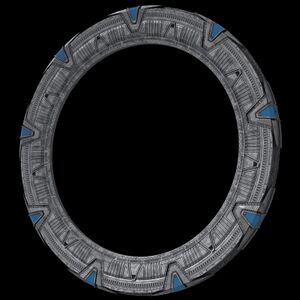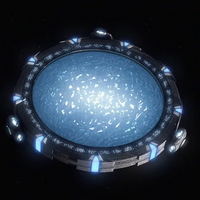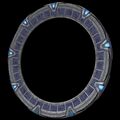

The Hermod Gate, developed by the Solas Tempus in conjunction with the United Federation of Planets and governed by the Hermod Consortium as part of Janus-Hermid treaty, is an advanced version of the Stargate. Unlike the original Stargates, which relied on the rare element Naquadah as a building material and powerful capacitor for wormhole generation, the Hermod Gate utilizes alternative technologies. The Hermod Consortium, named after the Norse messenger God of Frigg, is responsible for constructing and maintaining the gate network for the collective benefit of all. While member governments have control over gates within their territories, the Janus-Hermod Treaty ensures that no member can impede the operation of the gate network between political powers. This approach aligns with the established treaties governing warp drive and hyperspace travel as well as other universally accepted methods of space travel.
- Dimensions
- 6.7 Meter Diameter from Edge to Edge
4.9 Meter Diameter Opening - Power Source
- Fusion Reactors (2 or 4) or Matter/Antimatter Reactor (Powering the Wormhole)
Spacial Variance Reactor (Powering Control System) - Control System
- Onboard Encapsulated Computer Core
External Computer Core Supported - Transceiver
- Subspace-Tachyon Hybrid System
- Construction
- Tritanium-Neutronium Alloy
Hermod Gate Network
The original Stargates utilized a subspace communications network, with each gate acting as a passive relay, allowing the gate network to expand without the need for servers. The Dial Home Device (DHD) controlled the gates and used this transmission network to broadcast positioning updates between gates. While the Hermod Gate Network still accepts these subspace signals, it employs a hybrid tachyon-subspace transmission system. This hybrid system is similar to the one used in Hyperspace for navigation between Jump Gates. The subspace-tachyon hybrid system enables the gate network to utilize not only the gates themselves as relays but also transmission through Jump Gates, subspace relays, and other communication networks. The system possesses dynamic mode switching capabilities, allowing it to integrate with subspace relay networks used by any known race.
Each government has the freedom to choose its own symbology, and the dynamic symbol system updates to connect to gates that utilize different symbology. Generally, the gate symbols are determined by the official language of the respective government. The gate network is capable of accommodating any symbol.
Operation


The gate follows the design principles of Type 2 and 3 gates, while also incorporating some elements from the Type 1 gate. Primarily designed to work with a computer interface, the symbols on the gate are dynamic. The gate operates in three primary modes.
Direct Dial
Using a unique 9-symbol address, the gate can lock onto a remote gate based on its unique hardware address. The dynamic symbol system allows for an unlimited number of gates, using any possible symbols. Each gate is assigned a unique 9-symbol address, which is a holdover from the original Stargate system, maintained for compatibility.
In this mode, the gate itself calculates the position using nearby gates as reference points. This eliminates the need for the target gate to calculate its own position, enabling gates to establish contact across any distance.
Relative Dial
The original gate system employed a 6-symbol relational address with a 7th point of origin. As objects in space move at high speeds relative to each other, there are six "cardinal" gate locations corresponding to cardinal directions. These cardinal gates serve as reference points, allowing the system to calculate the precise relative location of a destination gate. By utilizing these six gate locations, the system can pinpoint a gate's position in three-dimensional space relative to an origin gate in real time. The Hermod Consortium assigns a symbol to each gate within the network, which can be used as either the point of origin or as a cardinal gate.
In this mode, both the target gate and the origin gate calculate their exact positions relative to the cardinal locations. Using this information, the gates cross-validate each other's positions. The relative position from origin to destination is then used to compute the Janus Coordinates for any wormhole.
Why is there a 7th Symbol?
The 7th Symbol allows the destination gate to verify the relative position calculation of the gate that contacted it. The gate system compares the 7th symbol with the gate that established contact, preventing a person from establishing a wormhole between two gates from a third gate. The 7th symbol is also used for authentication in some private gate networks or secure gate locations where travel is restricted. In such cases, the system compares the gate requesting a connection with the 7th symbol and ensures that the signal originates from the gate identified by the 7th symbol.
The system compares not only the signal contents, which establish the origin's unique 9-symbol gate location, but also the signal itself. If a mismatch is detected, verification is requested from the origin gate specified by the 7th symbol.
Cardinal Gates
Cardinal gates are strategically positioned at approximately 90-degree angles in three-dimensional space relative to each other. This configuration facilitates stable relative locks and provides optimal positioning. When three pairs of gates are configured, with each pair located roughly opposite and perpendicular to the other pairs, they create a set of cardinal gate locations. Since all objects in space are in motion relative to each other, there is a certain degree of leeway, but the paired cardinal gates should be on opposite sides of the target gate. Any gate can serve as a cardinal gate location for as many gates as necessary. The consortium selects these cardinal locations based on their relative stability in terms of both physical environment and political stability.
Multiple Networks
This mode enables gate access across networks. While the Hermod Gate Network serves as a single network with the Milky Way galaxy as its reference point, an 8th symbol can be used to target a remote gate network. The address system was designed to be local to a single galaxy, requiring exponentially more power to create a wormhole across the intergalactic void. This use of an 8th symbol also allows for the existence of isolated Stargate networks. According to the provisions outlined in the Janus-Hermod Treaty, any member government can create an isolated network for national security purposes. Such a gate network would require the use of an 8th symbol, which can be any symbol chosen.
While no extra-galactic gate networks have been established yet, the treaty assigns the responsibility to the Hermod Consortium to allocate a specific symbol to any gate network, including potential extra-galactic networks. In the original gate system, which was described when the first Stargates were discovered, the 8th symbol represented dialing a different galaxy. Although this method is not currently utilized, the treaty covers the use of a similar approach to specify direct connections to other networks. Technically, within the Milky Way, one can dial any gate within the Hermod Network directly, but the software blocks this capability and mandates the use of the 8th symbol even within the galaxy. This measure ensures that governments can maintain control over their borders.
Inter-Timeline / Inter-Reality Travel
The Hermod Consortium assigns a unique symbol to each timeline or subspace domain discovered through the Janus Project, which is used as the 8th symbol. When traveling to a destination gate in an alternate reality or timeline, the mechanics operate in a similar manner to connecting two gates within our own reality/timeline. The 8th symbol instructs the gate to target a gate in another reality or timeline and calculates the Janus Coordinates necessary to dial into that network.
In this type of operation, the same double-check procedure ensures accurate Janus Coordinates. The origin gate calculates the relative position of the destination gate, and the destination gate does the same. Real-time comparison of the relative positions facilitates a positive lock by each gate. The relative positions are used to compute the Janus Coordinates, and the origin gate initiates a wormhole to the destination gate. Gate-to-Gate travel is always preferred, especially for unprotected personnel.
Direct Control
When a computer system connected to the gate assumes direct control, it can override the internal calculations and directly establish a wormhole, effectively slaving the gate. In direct control mode, the gate accepts Janus Coordinates, enabling any gate with sufficient power to function as a Janus Gate.
Gate-to-Gate Wormhole
Under normal operation, the system establishes a wormhole directly between two gates. In these instances, the gate contains the event horizon of the wormhole. Crossing the event horizon causes matter to be dematerialized and transmitted through the wormhole as a matter stream, which is then rematerialized on the other side by the destination gate. This setup is one of the reasons why the original Stargates were primarily one-way, with the exception of electromagnetic radiation. The wormhole is designed to transmit a matter stream from one gate to another, similar to how a transporter operates.
By combining the Stargate with transporter technologies, the gates can operate bidirectionally, transmitting both matter and energy. This combination also allows for projecting a wormhole without a receiving gate, similar to how a transporter can rematerialize a person without a receiving transporter pad.
Wormhole Without a Gate
The new gate design allows for the projection of a wormhole without a gate on both ends. While it is safest to establish direct gate-to-gate connections, the gate can project a wormhole. In this scenario, the origin gate employs a method similar to a transporter to broadcast a matter stream through the wormhole, which then materializes on the other side.
Using a Transporter With an Active Wormhole
The gate itself is designed to dematerialize any matter crossing the event horizon into a matter stream. This matter stream is then rematerialized on the other side. Unlike transporters that utilize pattern buffers, the gates store the pattern within their own capacitors. The gate's pattern storage capacity is limited, only holding the pattern for a few seconds, making it less robust than a transporter with a pattern buffer. This is especially true when compared to a transporter that can beam to a receiving pad equipped with its own pattern buffer.
Since the gate does not alter the energy that enters the event horizon, a transporter can dematerialize matter and convert it into a matter stream within the transporter's pattern buffer. This matter stream can then be transmitted through the gate. Achieving synchronization between the transporter beam's subspace signal and the gate's wormhole subspace signature is essential. Once synchronization is established, the transporter can transmit the matter stream through the gate. As the wormhole connects two points in the multiverse, this method is preferred for transporting an unprotected individual through the gate to a location without a gate. The utilization of a transporter allows for additional safety precautions to protect individuals from potential pattern loss in the absence of a receiving gate to store the matter stream before transmission. The transporter protocol itself is more adept at handling such situations.
Power Source & Naquadah
Since the rare heavy element Naquadah does not exist in this reality, the gate employs an internal superconductive subspace amplifier. Rather than drawing and storing significant amounts of power for wormhole generation, the device utilizes an amplifier based on a concept similar to the Spacial Variance Reactor. However, instead of relying on a flow of verteron particles across the subspace field barrier, the device forces high-energy plasma through an artificial vacuum energy matrix. This process momentarily amplifies the power by four orders of magnitude, establishing the wormhole. Once the subspace connection is formed, the gate draws power at a much lower level to maintain the wormhole.
Security
Each Hermod Gate is equipped with a software package that allows the gate to relay any unwanted wormhole activity to another approved gate. This feature enables governments to control who can enter their territory and prevents gates from being weaponized against them. Additionally, the gates are equipped with force field generators capable of effectively closing a gate to incoming traffic. While the original Stargate documentation described methods involving force fields and physical irises to prevent gate travel to secure locations, both methods could lead to the death of individuals attempting to travel to such secured areas. The Hermod Gate force field closes the gate by preventing an incoming wormhole from establishing a connection, while the relaying program receives the matter stream from the incoming wormhole and forwards it through the network to a preselected auxiliary gate.
The treaty prohibits the use of force fields or any other technology that results in the death of incoming travelers on any open gate network.
The gate prevents connection establishment if a biological entity is present within the space where the wormhole would form. Gates terminate if nothing is transmitted through the wormhole within a configurable period of several seconds, typically between 3-7 seconds.
Private Gate Networks
Governments are entitled to build and use private gate networks. However, it is a violation of the treaty to operate a parallel gate network that mirrors the Hermod Gate Network within their territory, as it would undermine the Janus-Hermod Treaty.
To establish a private network, a government must register it with the Hermod Consortium. The government can then assign its own symbol to the gate network, provided the symbol is not already in use elsewhere. The consortium maintains a complete list of gate networks acceptable for travel. A gate network can be created to be completely separate from the Hermod Gate Network, but it still needs to be registered with the consortium if it utilizes Hermod Gates.
Failsafe
The gate software includes a failsafe mechanism that prevents the establishment of a connection if the wormhole would pass through stellar phenomena. Such wormhole passages could have disastrous consequences, including negative impacts on travelers or objects in space. Since the wormhole operates within subspace, most objects in space, including starships traveling at warp, are unaffected by a wormhole passing through them. However, stellar phenomena that create significant gravitational or magnetic fields crossing subspace layers can be affected. As a result, the gate software fails to connect if the wormhole's path intersects with these objects.
The gate software is capable of rerouting the wormhole through secondary and even tertiary gates to establish a connection while avoiding such phenomena, provided available gates are found. If the software plans to route the connection through multiple gates, it warns the user. The gates involved in rerouting the wormhole will be unavailable while the wormhole is active, but they will not display an active wormhole (i.e., they will not have an event horizon at the gate itself), although their lights will indicate activity.
Challenges of Gate Placement
Gates are commonly installed on moving objects, such as planets orbiting their suns and solar systems revolving around the galactic core. This means that gates can be placed on various objects, including spacecraft. However, to establish a wormhole, a gate must be present on a vessel traveling in normal space at sub-light speeds. For a spacecraft to have a gate with an active wormhole, it should be as close to stationary as possible. The subspace-inertial forces that arise during wormhole establishment can cause significant damage to a vessel attempting to travel at even moderate speeds. Unlike planets, which are protected by their gravitational fields, spacecraft lack the ability to generate such a field. Therefore, it is preferable to place gates on planetary bodies, with a preference for Class C worlds or larger, having a radius of at least 500 km. Gas giants like Class J (Jovian), I (Uranian), or larger planets are not suitable for surface gate placement. However, orbital outposts can be constructed for these gates, provided they are in a low orbit and can leverage the gravitational warping of space-time to shield them from the subspace-inertial forces. Without a strong gravitational pull to anchor them, orbital gates could easily be pulled out of orbit by these forces. Ideally, Class S (Supergiant) and Class T (Transitional Giant) or Class U (Ultragiant) planets are the most suitable for orbital gate placement due to their significantly higher gravitational fields.
Exterior
-
Front On
-
Back On
-
Top Off
-
Top On



